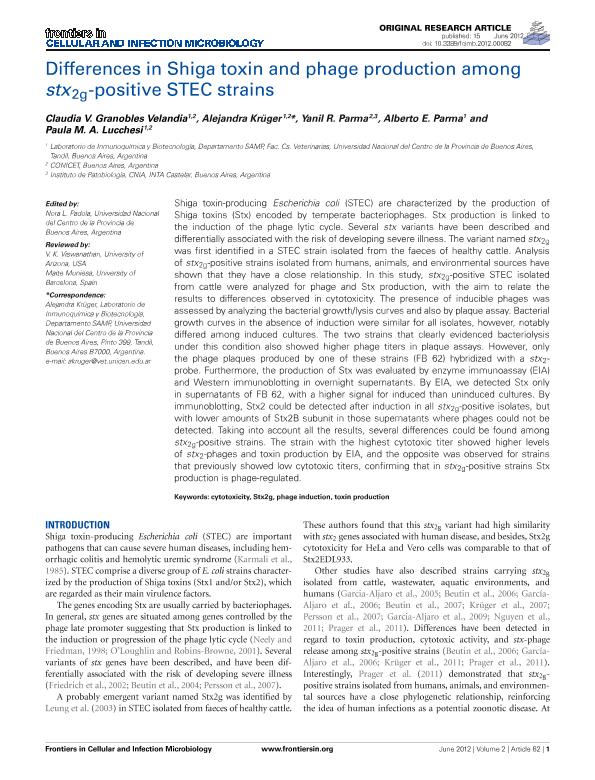Mostrar el registro sencillo del ítem
dc.contributor.author
Granobles Velandia, Claudia Viviana

dc.contributor.author
Krüger, Alejandra

dc.contributor.author
Parma, Yanil Renee

dc.contributor.author
Parma, Alberto Ernesto

dc.contributor.author
Lucchesi, Paula Maria Alejandra

dc.date.available
2019-02-27T20:22:45Z
dc.date.issued
2012-06
dc.identifier.citation
Granobles Velandia, Claudia Viviana; Krüger, Alejandra; Parma, Yanil Renee; Parma, Alberto Ernesto; Lucchesi, Paula Maria Alejandra; Differences in Shiga toxin and phage production among stx2g-positive STEC strains; Frontiers Research Foundation; Frontiers in Cellular and Infection Microbiology; 2; 6-2012; 1-5; 82
dc.identifier.issn
2235-2988
dc.identifier.uri
http://hdl.handle.net/11336/70917
dc.description.abstract
Shiga toxin-producing Escherichia coli (STEC) are characterized by the production of Shiga toxins (Stx) encoded by temperate bacteriophages. Stx production is linked to the induction of the phage lytic cycle. Several stx variants have been described and differentially associated with the risk of developing severe illness. The variant named stx2g was first identified in a STEC strain isolated from the faeces of healthy cattle. Analysis of stx2g-positive strains isolated from humans, animals, and environmental sources have shown that they have a close relationship. In this study, stx2g-positive STEC isolated from cattle were analyzed for phage and Stx production, with the aim to relate the results to differences observed in cytotoxicity. The presence of inducible phages was assessed by analyzing the bacterial growth/lysis curves and also by plaque assay. Bacterial growth curves in the absence of induction were similar for all isolates, however, notably differed among induced cultures. The two strains that clearly evidenced bacteriolysis under this condition also showed higher phage titers in plaque assays. However, only the phage plaques produced by one of these strains (FB 62) hybridized with a stx2-probe. Furthermore, the production of Stx was evaluated by enzyme immunoassay (EIA) and Western immunoblotting in overnight supernatants. By EIA, we detected Stx only in supernatants of FB 62, with a higher signal for induced than uninduced cultures. By immunoblotting, Stx2 could be detected after induction in all stx2g-positive isolates, but with lower amounts of Stx2B subunit in those supernatants where phages could not be detected. Taking into account all the results, several differences could be found among stx2g-positive strains. The strain with the highest cytotoxic titer showed higher levels of stx2-phages and toxin production by EIA, and the opposite was observed for strains that previously showed low cytotoxic titers, confirming that in stx2g-positive strains Stx production is phage-regulated.
dc.format
application/pdf
dc.language.iso
eng
dc.publisher
Frontiers Research Foundation

dc.rights
info:eu-repo/semantics/openAccess
dc.rights.uri
https://creativecommons.org/licenses/by-nc-sa/2.5/ar/
dc.subject
Cytotoxicity
dc.subject
Stx2g
dc.subject
Phage Induction
dc.subject
Toxin Production
dc.subject.classification
Otras Ciencias Veterinarias

dc.subject.classification
Ciencias Veterinarias

dc.subject.classification
CIENCIAS AGRÍCOLAS

dc.title
Differences in Shiga toxin and phage production among stx2g-positive STEC strains
dc.type
info:eu-repo/semantics/article
dc.type
info:ar-repo/semantics/artículo
dc.type
info:eu-repo/semantics/publishedVersion
dc.date.updated
2019-01-23T18:53:14Z
dc.journal.volume
2
dc.journal.pagination
1-5; 82
dc.journal.pais
Suiza

dc.description.fil
Fil: Granobles Velandia, Claudia Viviana. Universidad Nacional del Centro de la Provincia de Buenos Aires. Facultad de Ciencias Veterinarias. Departamento de Sanidad Animal y Medicina Preventiva. Laboratorio de Inmunoquímica y Biotecnología; Argentina. Consejo Nacional de Investigaciones Científicas y Técnicas; Argentina
dc.description.fil
Fil: Krüger, Alejandra. Universidad Nacional del Centro de la Provincia de Buenos Aires. Facultad de Ciencias Veterinarias. Departamento de Sanidad Animal y Medicina Preventiva. Laboratorio de Inmunoquímica y Biotecnología; Argentina. Consejo Nacional de Investigaciones Científicas y Técnicas; Argentina
dc.description.fil
Fil: Parma, Yanil Renee. Instituto Nacional de Tecnología Agropecuaria. Centro de Investigación en Ciencias Veterinarias y Agronómicas. Instituto de Patobiología; Argentina. Consejo Nacional de Investigaciones Científicas y Técnicas; Argentina
dc.description.fil
Fil: Parma, Alberto Ernesto. Universidad Nacional del Centro de la Provincia de Buenos Aires. Facultad de Ciencias Veterinarias. Departamento de Sanidad Animal y Medicina Preventiva. Laboratorio de Inmunoquímica y Biotecnología; Argentina. Consejo Nacional de Investigaciones Científicas y Técnicas; Argentina
dc.description.fil
Fil: Lucchesi, Paula Maria Alejandra. Universidad Nacional del Centro de la Provincia de Buenos Aires. Facultad de Ciencias Veterinarias. Departamento de Sanidad Animal y Medicina Preventiva. Laboratorio de Inmunoquímica y Biotecnología; Argentina. Consejo Nacional de Investigaciones Científicas y Técnicas; Argentina
dc.journal.title
Frontiers in Cellular and Infection Microbiology
dc.relation.alternativeid
info:eu-repo/semantics/altIdentifier/doi/http://dx.doi.org/10.3389/fcimb.2012.00082
dc.relation.alternativeid
info:eu-repo/semantics/altIdentifier/url/https://www.frontiersin.org/articles/10.3389/fcimb.2012.00082/full
Archivos asociados
